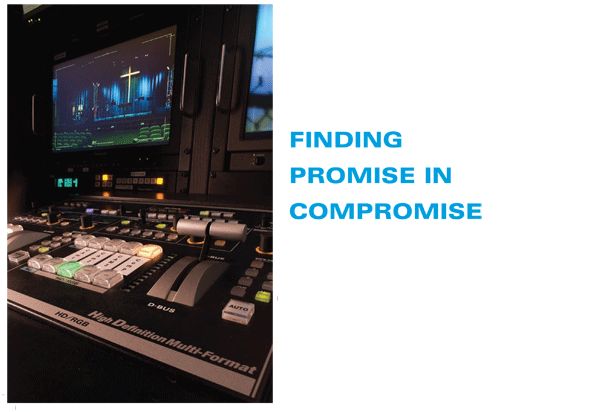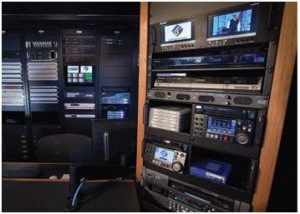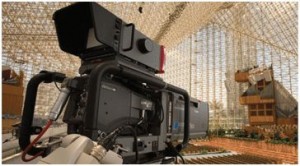The HD Upgrade

In the past few years, the dropping cost of HD equipment and rising availability and variety of HD functionality have made HD technology a viable consideration for mid-sized and smaller houses of worship. As a result, the migration to HD production is no longer a question of if, but rather a question of how and when. If the church is using video production internally and its SD systems are providing an acceptable level of quality, an upgrade likely can wait. If, on the other hand, the congregation feels that higher-quality images are needed for the worship area’s IMAG system, or if the church is looking to create a future path for additional outreach through broadcast, video streaming, or DVD distribution, then the upgrade to HD likely is a sound plan.
Though the quality provided by HD cameras and other systems may not be a necessity, the reality is that the cost differential between SD and HD systems has narrowed to the point that an HD investment is the smart short- and long-term investment. The modular design of many HD-capable systems provides a much more fluid upgrade path – and means of maintaining the value of equipment – than previously has been possible. Once the church has determined that an upgrade truly is needed, then it can address the significant challenge of planning and executing the project.
While larger churches are more likely to make incremental shifts to HD, small and mid-size churches tend to take on the upgrade all at once. Given the limited budgets of most houses of worship, this process tends to demand compromises. The key to getting the upgrade right lies in making the right compromises, and the right compromises are determined by defining how the church intends to use media as an outreach tool. What end product and distribution method are necessary to meet this goal? With these factors identified, the church can work backwards to identify the workflow, signal path, and technologies needed to make delivery of the worship message possible.
For smaller churches, many of which manage without significant in-house A/V and engineering staff, the aid of a systems integrator can be especially valuable in outlining all of the factors and requirements involved in an upgrade. The systems integrator can bring in products from different manufacturers, propose a workflow, and ensure that the project team at the church knows just what they’re getting, and what they’re not, in a given solution at a particular price point.
It is easy to get caught up in the idea of all that can be accomplished with an upgrade. If, early on, churches can identify what their budgets realistically will accommodate, they can spend time more effectively determining feasible options for their HD upgrade. With an understanding of the true cost of each compromise, the church can balance features against cost, and swap certain features for others, to get as close as possible to the ideal solution while still meeting the project budget.
Because the demands of production in the worship market are typically less stringent than in the broadcast realm, churches can approach their HD upgrades somewhat differently and, in doing so, mitigate some of the associated costs. Generally speaking, the same basic HD systems can be used to support IMAG, Web streaming, broadcast, and DVD distribution. With a wide array of products to choose from, the house of worship can identify and adopt the particular features or functionality suited to its media plan.
In selecting production systems, one way to reduce costs is to invest in products that consolidate a number of functions into a single system. For example, any number of switchers at any number of price points can handle the inputs and outputs used in video production at a small or mid-sized church. An inexpensive 12-input switcher would do the job for most purposes. In this market, however, those switching systems that incorporate character generators (CGs) and built-in routers are popular, as they address several needs at a lower cost than would three discrete systems. Additional features including built-in multiviewers also offer attractive functionality at an appealing price. While initially designed for SD operations, an increasing number of these systems are being engineered for professional HD applications.
In selecting switching systems, the church can save money by going with fewer M/E (mix/effects) banks. A 1-M/E switcher will be limited in the number of effects it can support, but it also affords an opportunity for cost savings if only simple switching and transitions are needed. To reduce the cost of routing systems, the church can consider hard-wiring connections with a patch bay. Again, a good deal of flexibility gets lost, as physical rewiring is required in order to change the signal path. If connections are expected to remain unchanged, once established, then direct wiring may be a reasonable solution. If not, then the investment in a router will enable reconfiguration of the signal path with just a few presses of a button.
Another area in which compromises may be made is in cabling and infrastructure. Multicore cabling can support older technologies that provide a good picture, but when looking at the signal path and planning for the future, it likely pays for the house of worship to upgrade the wiring to support the types of cameras that will be used for capture, both now and in the future. Infrastructure upgrades are less expensive as part of the initial installation than as an afterthought.
 What houses of worship may not realize in taking on their HD upgrades is that in taking the project through to completion, regardless of the cost or complexity of the project, the two greatest expenses are the capital equipment purchase and the installation labor. Without spending adequate time in planning the upgrade and properly designing the system, the church will wind up spending more money on equipment and labor. A well thought out plan can mitigate those costs by identifying by make, model, and quantity every piece of equipment and how much labor will be required to install it. In other words, a good plan for signal path and workflow eliminates surprises and added costs. In this way, the church can avoid difficult and unexpected compromises – whether to the budget or to the systems involved.
What houses of worship may not realize in taking on their HD upgrades is that in taking the project through to completion, regardless of the cost or complexity of the project, the two greatest expenses are the capital equipment purchase and the installation labor. Without spending adequate time in planning the upgrade and properly designing the system, the church will wind up spending more money on equipment and labor. A well thought out plan can mitigate those costs by identifying by make, model, and quantity every piece of equipment and how much labor will be required to install it. In other words, a good plan for signal path and workflow eliminates surprises and added costs. In this way, the church can avoid difficult and unexpected compromises – whether to the budget or to the systems involved.
Messaging is everything in the house of worship market. While the planning and implementation of a cost-effective HD upgrade will require some compromises, the installation will be a success if the church remains faithful to its mission and the media goals it defined when first undertaking the project. By defining a clear plan and taking an educated approach to product selection, churches can get the most out of their investment and enjoy both improved image quality in production and a more powerful tool for communication and outreach.




